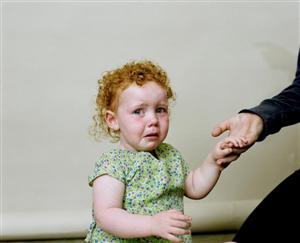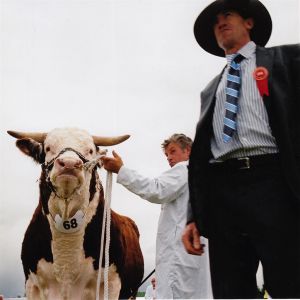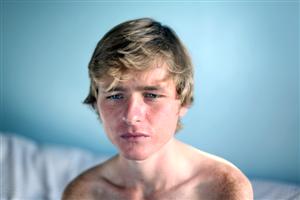Hereford Photography Festival | reviews, news & interviews
Hereford Photography Festival
Hereford Photography Festival
Cider, bulls and a beautifully restored cathedral which hosts the annual Three Choirs Festival are probably the key elements used to brand Hereford. But for 20 years, the city has also been home to the UK’s first photography festival. This month, its anniversary is being celebrated in several venues with the focus on Twenty, an exhibition at the charmingly old-fashioned Museum and Gallery where 20 significant photographers share wall space with a gigantic stuffed pike.
Hanging over the Market Square, banners printed with portraits of African women in brightly coloured robes represent the UK’s best-known punkish maverick, Rankin. Created for an Oxfam project in a Congolese village of displaced people, sadly it is barely noticeable here.
 To mark the festival’s anniversary, the Twenty photographers were chosen from its back catalogues and include groundbreaking and iconic photographers who mostly represent the recent end of its two-decade history. Among them are the best-known UK representatives, Martin Parr and Simon Norfolk, local film-maker and documentary portraitist John Bulmer, South Africans Guy Tillim and Roger Ballen, and festival co-founders Dave West and Al Vandenberg. Portraits and documentary images dominate the show, and include Parr’s new series, White Kenyans, which has the air of self-cliché, and Simon Norfolk’s Full Spectrum Dominance (pictured above) which illustrates America’s methods for testing weapons with a deceptively sublime shot of a nuclear missile launch. Coincidentally, that links to Paul Shambroom’s neat street scenes in suburban America where defunct military hardware is planted as street furniture.
To mark the festival’s anniversary, the Twenty photographers were chosen from its back catalogues and include groundbreaking and iconic photographers who mostly represent the recent end of its two-decade history. Among them are the best-known UK representatives, Martin Parr and Simon Norfolk, local film-maker and documentary portraitist John Bulmer, South Africans Guy Tillim and Roger Ballen, and festival co-founders Dave West and Al Vandenberg. Portraits and documentary images dominate the show, and include Parr’s new series, White Kenyans, which has the air of self-cliché, and Simon Norfolk’s Full Spectrum Dominance (pictured above) which illustrates America’s methods for testing weapons with a deceptively sublime shot of a nuclear missile launch. Coincidentally, that links to Paul Shambroom’s neat street scenes in suburban America where defunct military hardware is planted as street furniture.
Of the portraits, the most quietly poignant are by John Bulmer, the first photographer to depict the North of England in colour (in the 1960s). His 1968 series, Appalachia, repeats that challenge when photographing poor white American families: an exhausted woman with filthy bare feet wearing a blue dress is a new translation of Dorothea Lange’s classic Dust Bowl image. Jackie Nickerson, in contrast, approaches identity through portraits of neighbours in her village outside Dublin. Girl with a Green Dress (pictured below) represents her cliché-breaking approach: in spite of the quintessentially Irish freckles, red hair and pale skin, she avoids the sentimentality often associated with "Irishness".
 Falling into a category of her own, Liza Dracup’s magical woodland scenes, photographed between sunset and sunrise, are so richly colourful as to suggest intense digital post-production. In fact, she explains, they represent the current trend of maintaining old traditions and uses large-format negatives enlarged to create the dreamworld effect.
Falling into a category of her own, Liza Dracup’s magical woodland scenes, photographed between sunset and sunrise, are so richly colourful as to suggest intense digital post-production. In fact, she explains, they represent the current trend of maintaining old traditions and uses large-format negatives enlarged to create the dreamworld effect.
The surprise of the festival is an exhibition inside Hereford Cathedral where the English photographer Tessa Bunney pays homage to the symbol of the city: the prize Hereford bull (pictured below, Tenbury Show). Archival photographs and Bunney’s contemporary portraits of the animals and their breeders accompany bull memorabilia and collages of old prize rosettes. Hanging next to the tomb of a knight and glowing symbolically below stained glass windows, this small show is a curiously pagan intrusion into a sacred space, and one of the most alluring in the festival.
 At the Courtyard Arts Centre, 20 “fresh and new” photographers distilled from over 200 applicants to the [Open Here] competition inhabit real time and point to future familiarity. The winner, Jason Larkin, carries a maturity born of years as a documentary travel photographer. Past Perfect – Museum, set in a series of museum rooms, is a sumptuously lit depiction of scale and time. The £2,000 prize funds a commission for next year’s festival.
At the Courtyard Arts Centre, 20 “fresh and new” photographers distilled from over 200 applicants to the [Open Here] competition inhabit real time and point to future familiarity. The winner, Jason Larkin, carries a maturity born of years as a documentary travel photographer. Past Perfect – Museum, set in a series of museum rooms, is a sumptuously lit depiction of scale and time. The £2,000 prize funds a commission for next year’s festival.
For me, the young Korean oncology surgeon Noh Sang Ik stands out for his original approach to documentary, strong sense of design in some wince-inducing but beautiful still-lifes. The English portraitist Clare Park focuses on skin, flesh tones and vulnerability – sheathing her mother protectively inside a blanket. Looking for links, I see Laura Pannack handling the familiar subject of young people’s eating disorders (pictured below, Graham) but she defies the clichés of skeletal bodies.
 Becky Matthews straddles both the [Open Here] collection and her collaboration with the Royal National College for the Blind in Focus Here exhibitions and talks. She oversaw visually and touchably readable art works and road signs positioned around the venue - a revelation about the use of photography for blind and visually impaired people. Accomanying it is Sights Unseen, a touring exhibition curated by the London charity PhotoVoice, and including works from China, Mexico and Israel, which all defy expectations - and fit surprisingly well among current trends for blurred, off-centre, unconventionally composed images sold for high prices by many successful and sighted photographers.
Becky Matthews straddles both the [Open Here] collection and her collaboration with the Royal National College for the Blind in Focus Here exhibitions and talks. She oversaw visually and touchably readable art works and road signs positioned around the venue - a revelation about the use of photography for blind and visually impaired people. Accomanying it is Sights Unseen, a touring exhibition curated by the London charity PhotoVoice, and including works from China, Mexico and Israel, which all defy expectations - and fit surprisingly well among current trends for blurred, off-centre, unconventionally composed images sold for high prices by many successful and sighted photographers.
What started as an ambitious dream project 20 years ago, in a city way off the main photographic drag (which 20 years ago meant London), has blossomed into one of Britain’s landmark photography events.
- Visit Hereford Photography Festival 20 until 27 November
- View Sights Unseen exhibition on PhotoVoice website
more Visual arts
 Stephen review - a breathtakingly good first feature by a multi-media artist
Melanie Manchot's debut is strikingly intelligent and compelling
Stephen review - a breathtakingly good first feature by a multi-media artist
Melanie Manchot's debut is strikingly intelligent and compelling
 Fantastic Machine review - photography's story from one camera to 45 billion
Love it or hate it, the photographic image has ensnared us all
Fantastic Machine review - photography's story from one camera to 45 billion
Love it or hate it, the photographic image has ensnared us all
 Yinka Shonibare: Suspended States, Serpentine Gallery review - pure delight
Weighty subject matter treated with the lightest of touch
Yinka Shonibare: Suspended States, Serpentine Gallery review - pure delight
Weighty subject matter treated with the lightest of touch
 Jane Harris: Ellipse, Frac Nouvelle-Aquitaine MÉCA, Bordeaux review - ovals to the fore
Persistence and conviction in the works of the late English painter
Jane Harris: Ellipse, Frac Nouvelle-Aquitaine MÉCA, Bordeaux review - ovals to the fore
Persistence and conviction in the works of the late English painter
 Sargent and Fashion, Tate Britain review - portraiture as a performance
London’s elite posing dressed up to the nines
Sargent and Fashion, Tate Britain review - portraiture as a performance
London’s elite posing dressed up to the nines
 Zineb Sedira: Dreams Have No Titles, Whitechapel Gallery review - a disorientating mix of fact and fiction
An exhibition that begs the question 'What and where is home?'
Zineb Sedira: Dreams Have No Titles, Whitechapel Gallery review - a disorientating mix of fact and fiction
An exhibition that begs the question 'What and where is home?'
 Yoko Ono: Music of the Mind, Tate Modern review - a fitting celebration of the early years
Acknowledgement as a major avant garde artist comes at 90
Yoko Ono: Music of the Mind, Tate Modern review - a fitting celebration of the early years
Acknowledgement as a major avant garde artist comes at 90
 Unravel: The Power and Politics of Textiles in Art, Barbican review - the fabric of dissent
An ambitious exploration of a neglected medium
Unravel: The Power and Politics of Textiles in Art, Barbican review - the fabric of dissent
An ambitious exploration of a neglected medium
 When Forms Come Alive, Hayward Gallery review - how to reduce good art to family fun
Seriously good sculptures presented as little more than playthings or jokes
When Forms Come Alive, Hayward Gallery review - how to reduce good art to family fun
Seriously good sculptures presented as little more than playthings or jokes
 Entangled Pasts 1768-now, Royal Academy review - an institution exploring its racist past
After a long, slow journey from invisibility to agency, black people finally get a look in
Entangled Pasts 1768-now, Royal Academy review - an institution exploring its racist past
After a long, slow journey from invisibility to agency, black people finally get a look in
 Barbara Kruger, Serpentine Gallery review - clever, funny and chilling installations
Exploring the lies, deceptions and hyperbole used to cajole, bully and manipulate us
Barbara Kruger, Serpentine Gallery review - clever, funny and chilling installations
Exploring the lies, deceptions and hyperbole used to cajole, bully and manipulate us
 Richard Dorment: Warhol After Warhol review - beyond criticism
A venerable art critic reflects on the darkest hearts of our aesthetic market
Richard Dorment: Warhol After Warhol review - beyond criticism
A venerable art critic reflects on the darkest hearts of our aesthetic market

Add comment